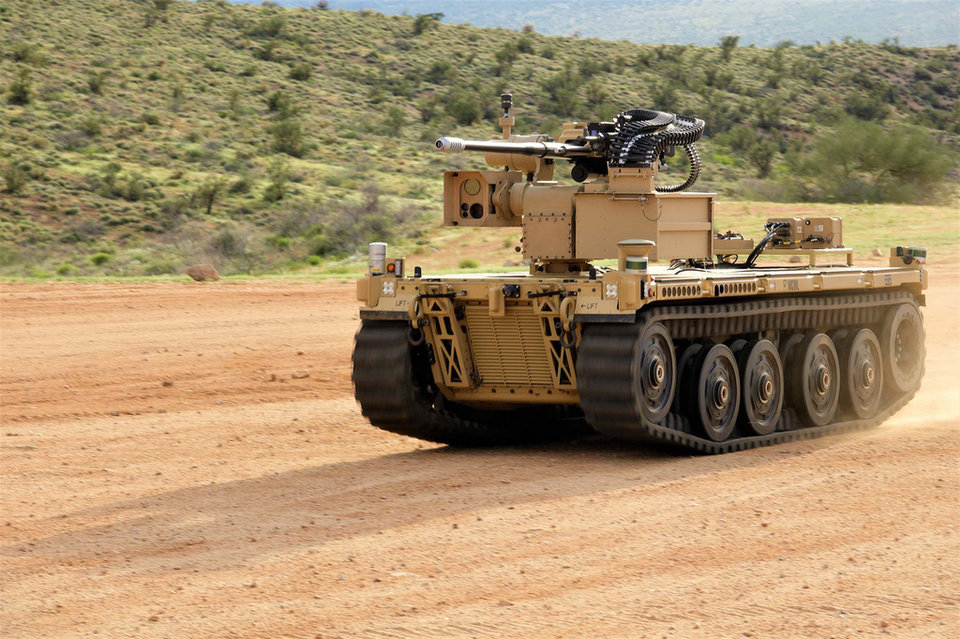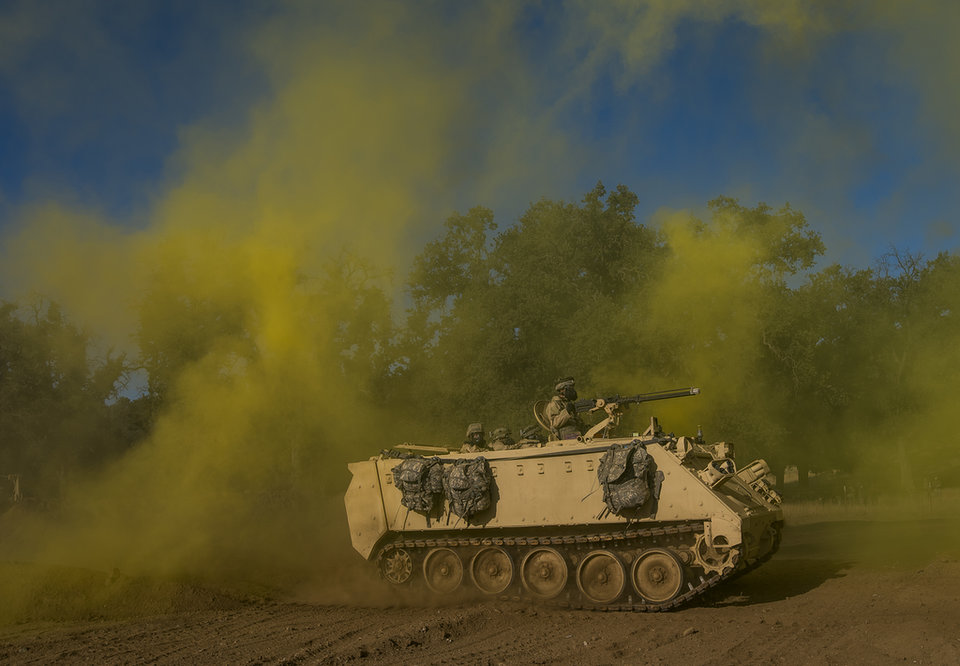LAND
DARPA’s Grand Challenge at 15: how far have autonomous military vehicles come?
Fifteen years ago, DARPA conducted its groundbreaking Grand Challenge, which aimed to accelerate the development of autonomous military vehicle technology. Today, the commercial automotive world is fully embracing autonomous technologies, but can the same be said for the military? Grant Turnbull finds out.

// For its robotic combat vehicle programme, the US Army will leverage work already carried out on roboticising a weaponised Humvee. Image: US Army
Driving a car 142 miles across the desert from California to Nevada is not a simple task at the best of times. Now, imagine you are not allowed to drive the car and, instead, the vehicle has to think for itself and navigate the entire route autonomously. That was the challenge set by the US Defense Advanced Research Projects Agency (DARPA) in 2004 - known as the Grand Challenge - which aimed to bring the best and the brightest of the tech community together to fight it out for a $1m prize.
The only problem: none of the 15 teams and their associated vehicles that entered the 2004 competition could finish the route, with technical and route complexities proving to be far more challenging than originally anticipated. Not to be defeated, DARPA ran a second Grand Challenge in 2005, with 195 teams entering to compete and take home the higher $2m prize.
There was more success this time round, with five teams successfully navigating the course and Stanford University taking home the grand prize. The Grand Challenge pushed the boundaries in terms of what was technically possible in areas such as sensor technology - gathering situational data through radar, LIDAR and electro-optics - as well as complex software algorithms for processing the huge amounts of data collected and determining what course of action to take.
Fast-forward to today and autonomous vehicle technology is now rolling out to consumers, whether it is ‘basic’ self-driving functions such as lane keeping and autonomous emergency braking, or fully autonomous driving as seen on Tesla vehicles using their in-built Autopilot. Industry is also embracing this technology, with sectors such as mining now using robotic dumper trucks without human drivers to increase both safety and efficiencies.
The grand irony
The irony of the Grand Challenge, however, is that despite the competition predominantly focusing on how autonomous technologies could be used for military applications, armed forces around the world have ultimately been slow to adopt self-driving vehicles for combat operations.
Even the US DoD, with its huge research and development budget, has still not fully rolled out self-driving vehicles and continues to work on several projects in areas such as autonomous convoy missions, and robotic combat vehicles that work alongside manned assets in armoured formations.
“A far more challenging nut that the US Army is trying to crack is introducing autonomous vehicles into frontline combat formations to fight alongside manned vehicles.”
The US Army has been pursuing autonomous trucks for resupply missions for around a decade, the deadly lessons learnt from Iraq and Afghanistan being major drivers for this type of application. Now, the service wants to accelerate their introduction and has outlined plans - known as Expedient Leader-Follower (ExLF) - to get them into the hands of soldiers quicker for experimentation. This will begin with operational deployments of robotic trucks to two units next year as part of plans to properly develop tactics, techniques and procedures (TTPs).
Army sources have previously told us that the vehicles will still possess only basic autonomous functions, mainly being able to follow a lead vehicle driven by a human operator. Over time, through software-based updates, the army hopes to introduce more modes and functionality, including behavioural aspects where the vehicles can think for themselves and react to certain scenarios on the battlefield, including obstacles and attacks on the convoy.
A far more challenging nut that the US Army is trying to crack is introducing autonomous vehicles into frontline combat formations to fight alongside manned vehicles, also known as manned-unmanned teaming (MUM-T). This has become common in the aerial domain, with drones increasingly being utilised alongside piloted aircraft to increase safety for human crews. Encrypted data links ensure that pilots can view a drone’s video feed, giving greater situational awareness without risking flying over enemy territory, and drones can also carry out attack missions if required.

Pratt & Miller has tested its expeditionary modular autonomous vehicle as part of initial testing of a robotic combat vehicle. Image: Pratt & Miller
Teaming up with robots
Ground forces are keen to emulate this by using autonomous robotic vehicles in combat. As part of its Next Generation Combat Vehicle programme, the US Army not only wants an optionally-manned fighting vehicle to replace the Bradley fighting vehicle - which itself can function as an autonomous vehicle when required - but also a family of robotic combat vehicles (RCVs) that integrate into formations to support all warfighting operations that manned vehicles take part in. These RCVs will consist of light, medium and heavy variants.
This concept remains in its experimentation phase, with autonomous technologies developed for programmes such as ExLF likely to cross over. The army will begin operational user testing of two M113 armoured personnel carriers, converted to armed robotic platforms, later this year to better inform future requirements. These surrogate platforms are likely to be joined by robots supplied by industry in the coming years, with the platforms helping troops develop TTPs for frontline operations.
Six different robotic platforms were trialled in May as part of RCV’s phase II demonstration and assessment event, with a contract expected later this year according to army sources.
“Self-driving vehicles can only be relevant in combat scenarios if they can keep up and fight with humans at the objective.”
A host of challenges remain, not least when it comes to introducing weapon systems onto autonomous and robotic platforms. The Pentagon’s policy is that a human remains “in the loop” at all times when weapon systems are fired.
Much like DARPA’s Grand Challenge 15 years ago, how a vehicle autonomously navigates towards an objective and the speed at which it does so, remains a significant challenge. Armoured combat vehicles with well-trained crews can travel cross-country at blistering speeds and self-driving vehicles can only be relevant in combat scenarios if they can keep up and fight with humans at the objective. Initial iterations of these vehicles will likely be remote-controlled – similar to how Predator drones still have a human crew - rather than being fully autonomous.
This throws up yet even more technical challenges, not least when it comes to command links and ensuring that they are properly encrypted to ensure that enemy forces do not jam, or even hijack, robotic vehicles. The increasing congestion of the electromagnetic spectrum as more unmanned systems are introduced is also a hurdle to overcome, as armed forces have to ensure that the spectrum is managed correctly to avoid system outages.

The US Army's Next Generation Combat Vehicle programme will consist of both an optionally manned fighting vehicle and a family of autonomous robotic combat vehicles. Image: US Army
Incremental introduction
These challenges mean that the introduction of a robotic combat vehicle that can fight alongside tanks in combat could still be some way off. Instead, the military’s adoption of robotic vehicles will likely mirror the commercial world, with new-generation armoured vehicles incorporating more computing power, sensing technologies and drive-by-wire functionality to automate processes such as convoy operations.
So while there has been considerable progress from DARPA’s original Grand Challenge, particularly as self-driving cars become part of everyday life, there is still a significant amount of work to be done before self-driving armoured vehicles become part of everyday military life.

Two autonomous M113 armoured personnel carriers will go through user operational testing this year. Image: US Army